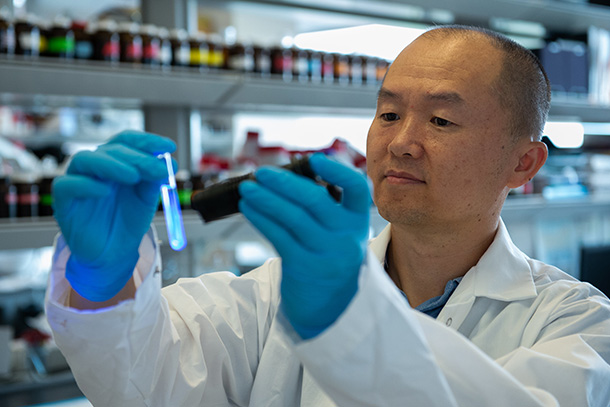
Jian Yang, professor of biomedical engineering, checks the fluorescence of the citrate polymers that will be used for gene delivery to treat peripheral arterial disease. Credit: Kelby Hochreither/Penn State
Researchers explore nanomaterials for imaging, medicine delivery for arterial disease
August 12, 2022
Editor’s note: A version of this article originally appeared on the University of Texas Arlington’s website.
UNIVERSITY PARK, Pa. — A team of multiple principal investigators that includes Jian Yang, Penn State professor of biomedical engineering in the College of Engineering and the Dorothy Foehr Huck and J. Lloyd Huck Chair in Regenerative Engineering in the Huck Institutes of the Life Sciences, received a four-year, $2.1 million grant from the National Institutes of Health (NIH) to develop biodegradable nanomaterials that will take pictures and deliver medicine to combat peripheral arterial disease (PAD).
The corresponding principal investigator for the project is Kytai Nguyen, professor of bioengineering at the University of Texas (UT) Arlington, where previously Yang was a faculty member. Ralph Mason, professor of radiology at UT Southwestern, is also on the project.
“What’s important in this project is that the technology carries fluorescent and ultrasound imaging capabilities, which will provide patients and doctors with more detailed information,” Nguyen said. “It also gives patients more targeted medicine, making it more efficient.”
PAD, more commonly known as either atherosclerosis or hardening of the arteries, is a condition commonly found in the elderly. It affects more than 200 million people worldwide and is associated with high rates of morbidity and mortality.
The research aims to develop novel biodegradable nanoparticles to deliver therapeutic agents that specifically protect cells under stress conditions, facilitate the formation of blood vessels under hypoxia and allow noninvasive multimodal imaging methods.
According to the researchers, these new nanoparticle platforms could be employed to deliver any therapeutics locally, treat the disease effectively and monitor the treatment noninvasively by imaging. The overall goal is to reduce complications and improve the quality of life for PAD patients, Yang said.
“Peripheral arterial diseases are mostly occurred in aging populations,” said Yang, who is also affiliated with the Penn State Materials Research Institute. “Our citrate-based multi-functional nanoparticles enable targeted gene delivery to promote blood vessel formation in a hostile ischemic tissue environment where oxygen is often in short supply. With the support of this NIH grant, we now have a chance to develop a convenient and effective therapy to improve of the quality of life of millions of PAD patients in this aging society.”



